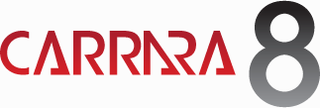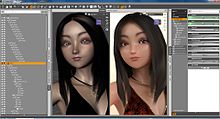Autodesk 3ds Max, formerly 3D Studio and 3D Studio Max, is a professional 3D computer graphics program for making 3D animations, models, games and images. It is developed and produced by Autodesk Media and Entertainment. It has modeling capabilities and a flexible plugin architecture and must be used on the Microsoft Windows platform. It is frequently used by video game developers, many TV commercial studios, and architectural visualization studios. It is also used for movie effects and movie pre-visualization. 3ds Max features shaders, dynamic simulation, particle systems, radiosity, normal map creation and rendering, global illumination, a customizable user interface, and its own scripting language.
Poser is a figure posing and rendering 3D computer graphics program distributed by Bondware. Poser is optimized for the 3D modeling of human figures. It enables beginners to produce basic animations and digital images, along with the extensive availability of third-party digital 3D models.

LightWave 3D is a 3D computer graphics program developed by LightWave Digital. It has been used in films, television, motion graphics, digital matte painting, visual effects, video game development, product design, architectural visualizations, virtual production, music videos, pre-visualizations and advertising.

3D Movie Maker is a children's computer program developed by Microsoft Home's Microsoft Kids subsidiary released in 1995. Using the program, users can make films by placing 3D characters and props into pre-rendered environments, as well as adding actions, sound effects, music, text, speech and special effects. Movies are then saved in the .3mm file format.

Bryce, also often referred to colloquially as Bryce3D, is a 3D modeling, rendering and animation program specializing in fractal landscapes. The name is taken from Bryce Canyon—a rugged region with many of the same landscapes that were first simulated with the software.
COLLADA is an interchange file format for interactive 3D applications. It is managed by the nonprofit technology consortium, the Khronos Group, and has been adopted by ISO as a publicly available specification, ISO/PAS 17506.

Autodesk Softimage, or simply Softimage was a 3D computer graphics application, for producing 3D computer graphics, 3D modeling, and computer animation. Now owned by Autodesk and formerly titled Softimage|XSI, the software has been predominantly used in the film, video game, and advertising industries for creating computer generated characters, objects, and environments.

Carrara is a full-featured 3D computer graphics application featuring figure posing and editing, as well as nature modeling, in addition to traditional modeling, animation, texturing and rendering. The software is also capable of dynamic hair and fur simulations, particle effects, soft body and rigid body dynamics. Carrara is now owned and developed by Daz 3D. Carrara is compatible with Poser and Daz Studio formats of 3D figures and props. It is further supported by a number of 3rd party plug-ins and add-ons.

3D computer graphics, sometimes called CGI, 3-D-CGI or three-dimensional computer graphics, are graphics that use a three-dimensional representation of geometric data that is stored in the computer for the purposes of performing calculations and rendering digital images, usually 2D images but sometimes 3D images. The resulting images may be stored for viewing later or displayed in real time.

Daz Productions, Inc. is a 3D-content and software company specialized in providing rigged 3D human models, associated accessory content, and software to hobbyists as well as the prosumer market.
Victoria is an articulated 3D female figure developed and sold by Daz 3D. There have been several "generations" of the figure, all bearing the same name.

Blue Mars, a 3D massively multiplayer virtual world platform developed by Hawaii-based Avatar Reality, allows 3rd parties to create virtual worlds, MMOG games, simulations, shops, businesses, entertainment venues, clothing, custom avatars, furniture, virtual homes, and other items. It consists of four main parts: the client software, the Sandbox Editor SDK suite, the website, and the host servers. It is often compared to Second Life, since both are virtual social worlds allowing user-created content. According to Jim Sink, CEO of Avatar Reality, "Blue Mars was inspired by a vision of the future when the power to terraform whole worlds is within our grasp. The name Blue Mars represents possibility and hope."
Messiah is a 3D animation and rendering application developed by pmG Worldwide. It runs on the Win32 and Win64 platforms. It is marketed to run on Mac OS X and Linux via Wine. Messiah's fourth version, messiah:studio was released April 2009 and version 5.5b as messiah:animate was released November 2006. messiahStudio6 was released in April 2013. Messiah seems no longer maintained since 2013 (abandoned).
Shade 3D is a 3D modeling, rendering, animation, 3D printing computer program developed by e frontier Japan and published by Mirye Software. In October 2013, Shade 3D development team formed a new company called Shade3D Co., Ltd., and continue to develop and market the program. After terminating the sales agreement with e frontier Japan and Mirye Software by the end of December 2014, Shade3D company is now developing and marketing Shade 3D products in Japan and worldwide exclusively.
iClone is a real-time 3D animation and rendering software program. Real-time playback is enabled by using a 3D videogame engine for instant on-screen rendering.

Away3D is an open-source platform for developing interactive 3D graphics for video games and applications, in Adobe Flash or HTML5. The platform consists of a 3D world editor, a 3D graphics engine, a 3D physics engine and a compressed 3D model file format (AWD).

In 3D computer graphics, 3D modeling is the process of developing a mathematical coordinate-based representation of a surface of an object in three dimensions via specialized software by manipulating edges, vertices, and polygons in a simulated 3D space.

Dan Farr is an entrepreneur, known for co-founding Daz 3D, a 3D content and software company, and for founding Salt Lake Comic Con.

Art of Illusion is a free software, and open source software package for making 3D graphics.








